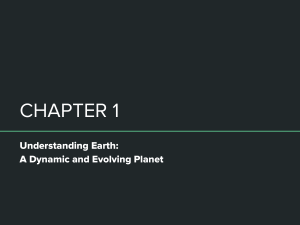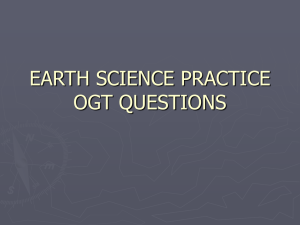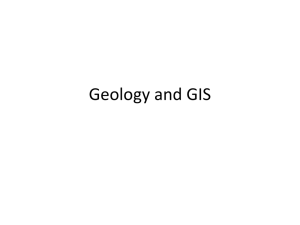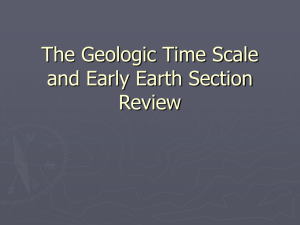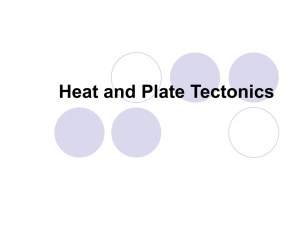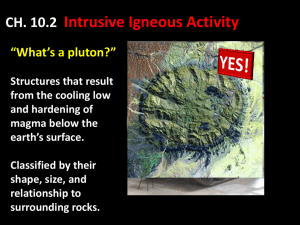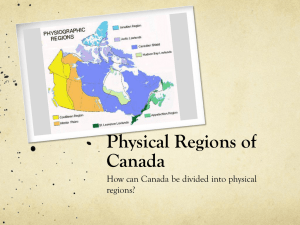chapter1
advertisement
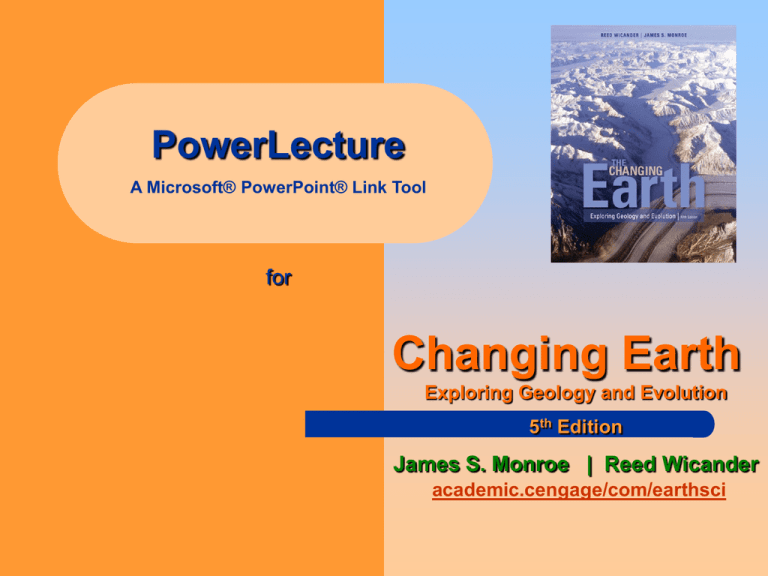
PowerLecture A Microsoft® PowerPoint® Link Tool for Changing Earth Exploring Geology and Evolution 5th Edition James S. Monroe | Reed Wicander academic.cengage/com/earthsci Chapter 1 Understanding Earth A Dynamic and Evolving Planet Introduction Geology is a complex, integrated system of related parts, components, or sub-systems. These interact in an organized fashion, affecting one another in various ways. The principal subsystems of the earth are the: Atmosphere Biosphere Hydrosphere Lithosphere Mantle Core Figure 1.1, p. 5 Evaporation, condensation, and precipitation transfer water between atmosphere and hydrosphere, influencing weather and climate and distribution of water. Plant, animal, and human activity affect composition of atmospheric gases. Atmospheric temperature and precipitation help to determine distribution of Earth’s biota. Atmosphere Atmospheric gases and precipitation contribute to weathering of rocks. Plants absorb and transpire water. Water is used by people for domestic, agricultural, and industrial uses. Hydrosphere Plate movement affects size, shape, and distribution of ocean basins. Running water and glaciers erode rock and sculpt landscapes. Biosphere Water helps determine abundance, diversity, and distribution of organisms. Heat reflected from land surface affects temperature of atmosphere. Distribution of mountains affects weather patterns. Plate Organisms break down rock into soil. People alter the landscape. Plate movement affects evolution and distribution of Earth’s biota. Convection cells within mantle contribute to movement of plates (lithosphere) and recycling of lithospheric material. Mantle Supplies heat for convection in mantle Core Stepped Art Fig. 1-1, p. 5 Introduction The interaction of these subsystems has resulted in a dynamically changing planet in which matter and energy are continuously recycled into different forms. Table 1.1, p. 6 What is Geology? Geology is the study of the Earth. Physical geology is concerned with the materials and processes which compose and operate on the surface of, and within, Earth. Historical geology is concerned with the origin and evolution of Earth's continents, oceans, atmosphere, and life. What is geology? Geologists are employed in diverse occupations. Principle occupations include: Mineral and energy resource exploration Solving environmental problems Predicting natural disasters Table 1.2, p. 6 Geology and the Formulation of Theories What is a theory? It is arrived at through the scientific method, which involves gathering and analyzing facts formulating hypotheses to explain the phenomenon testing the hypotheses and finally proposing a theory. The hypotheses is a tentative explanation. A scientific theory is a testable explanation for some natural phenomenon, that is supported by a large body of evidence. How Does Geology Relate to the Human Experience? Geology pervades our everyday lives and is a part of many aspects of human experience, including the arts and literature. The range of environmental problems and issues of concern to society require a basic understanding of geology. Figure 1.2, p. 7 How does geology affect our daily lives? Natural Events Economics and Politics Our Role as Decision Makers Consumers and Citizens Sustainable Development Figure 1.3, p. 8 9203 kg Clays 348 kg Zinc 774,000 kg Stone, sand, and gravel 311,034 l Petroleum 14,359 kg Salt 159,880 m3 Natural gas 33,771 kg Cement >30,615 kg Other minerals and metals 14,694 kg Iron ore 410 kg Lead 2438 kg Bauxite (Aluminum) 260,530 kg Coal 629 kg Copper 44 g Gold 8301 kg Phosphate rock Stepped Art Fig. 1-3, p. 8 Global Geologic and Environmental Issues Facing Humankind Most scientists would argue that overpopulation is the greatest problem facing the world today. Increasingly large numbers of people must be fed, housed, and clothed, with a minimal impact on the environment. Global Geologic and Environmental Issues Facing Humankind The greenhouse effect is the retention of heat in the atmosphere. Mankind has been adding to the greenhouse. This results in an increase in the temperature of Earth’s surface and atmosphere, thus producing global warming. Figure 1.4, p. 9 a) Short-wavelength radiation from the Sun that is not reflected back into space penetrates the atmosphere and warms Earth’s surface. b) Earth’s surface radiates heat in the form of long–wavelength radiation back into the atmosphere, where some of it escapes into space. The rest is absorbed by greenhouse gases and water vapor and reradiated back toward Earth. c) Increased concentrations of greenhouse gases trap more heat near Earth’s surface, causing a general increase in surface and atmospheric temperatures, which leads to global warming. Stepped Art Fig. 1-4, p. 9 Origin of the Universe Did it begin with a Big Bang? In the Big Bang theory, the universe began approximately 15 billion years ago. An extremely dense, hot body of matter expanded and cooled Origin of the Universe How do we know? Evidence for the Big Bang: the universe is expanding from a central point. The entire universe has a pervasive and constant background radiation, thought to be the faint afterglow of the Big Bang. Fig. 1.8c, p. 16 Our Solar System Its Origin and Evolution The Solar System formed from a rotating cloud of interstellar matter about 4.6 billion years ago. This cloud, upon condensing, collapsed under the influence of gravity and flattened into a rotating disk. The sun, planets, and moons formed within this disk. Figure 1.7, p. 16 Earth Its Place in Our Solar System Earth formed from a swirling eddy of nebular material 4.6 billion years ago, accreting as a solid body and soon thereafter differentiated into a layered planet during a period of internal heating. Fig. 1.9, p. 17 Why Earth is a Dynamic and Evolving Planet Earth has continuously changed during its 4.6 billion year existence as a result of interactions between its various subsystems and cycles. Why Earth is a Dynamic and Evolving Planet As the earth differentiated, 3 concentric layers formed. Core Mantle Crust. Fig. 1.10, p. 18 Why Earth is a Dynamic and Evolving Planet The Core The core consists of a small, solid inner region a larger, liquid, outer portion Composed of iron and a small amount of nickel. Fig. 1.10, p. 18 Why Earth is a Dynamic and Evolving Planet The Mantle The mantle surrounds the core and is divided into: a solid lower mantle an asthenosphere that behaves plastically and flows slowly a solid upper mantle. Composed primarily of peridotite, an igneous rock made of olivine. Fig. 1-10, p. 18 Why Earth is a Dynamic and Evolving Planet The Crust The outermost layer, the crust, is divided into: thick continental crust thin oceanic crust Fig. 1.10, p. 18 Why Earth is a Dynamic and Evolving Planet The Asthenosphere Surrounds the lower mantle Behaves plastically and slowly flows Partial melting in the asthenosphere generates magma (molten rock) that rises to the earth’s surface. Fig. 1.10, p. 18 Why Earth is a Dynamic and Evolving Planet The Lithosphere The crust and upper mantle make up the lithosphere which forms the solid outer layers of the Earth. Fig. 1.10, p. 18 Why Earth is a Dynamic and Evolving Planet Plate Tectonic Theory The lithosphere is composed of rigid plates that diverge, converge, or slide sideways past one another as they move over the asthenosphere Fig. 1.11, p. 18 Mid-oceanic ridge Trench Ocean Subduction Oceanic lithosphere Continental lithosphere Convection cell Cold Upwelling Outer core Hot Mantle Inner core Stepped Art Fig. 1-11, p. 18 Why Earth is a Dynamic and Evolving Planet Plate Tectonic Theory Fig. 1.12, p. 19 Why Earth is a Dynamic and Evolving Planet Plate Tectonic Theory Volcanoes and earthquakes occur at the boundaries between the plates. Fig. 1.13, p. 19 Why Earth is a Dynamic and Evolving Planet Plate Tectonics and Earth Systems Plate tectonic theory is a unifying explanation for many geologic features and events, helping us understand the composition and internal processes of Earth on a global scale. The Rock Cycle A rock is a solid aggregate of one or more minerals, as well as non-crystalline matter such as natural glass or organic material like coal. There are three major groups of rocks Igneous Sedimentary Metamorphic Fig. 1.14, p. 21 The Rock Cycle Igneous Rocks form from the crystallization of magma as it cools or the consolidation of volcanic ejecta. Granite Intrusive Igneous Rock Basalt Extrusive Igneous Rock Intrusive igneous rock crystallizes beneath the earth’s surface. Extrusive igneous rock crystallizes and cools at the earth’s surface. At times it cools so fast that it forms a glass or ash. Fig. 1.15 a-b, p. 22 The Rock Cycle Sedimentary Rocks are typically deposited in layers formed from: rock/mineral fragments precipitation of minerals from solution the compaction of plant and animal remains. Conglomerate Forms from river gravels Limestone Precipitation from seawater Fig. 1.15 c-d, p. 22 The Rock Cycle Metamorphic Rocks form from alteration of other rocks, usually by: Heat Pressure Chemically active fluids Gneiss Quartzite Fig. 1.15 e-f, p. 22 The Rock Cycle The rock cycle illustrates the interactions between Earth’s internal and external processes and how the three rock groups are interrelated. Fig. 1.14, p. 21 The Rock Cycle How are the rock cycle and plate tectonics related? Plate movement is the driving mechanism of the rock cycle. Plate interaction determines, to some extent, which of the three rock groups will form. Fig. 1.16, p. 23 Organic Evolution and the History of Life The theory of organic evolution states: that all living things are related and have descended with modification from organisms living in the past. Charles Darwin proposed that the mechanism of natural selection results in survival reproductive age of those organisms best suited to their environment. Fossils, the remains of once-living organisms provide the evidence for evolution and a history of life before humans. Organic Evolution and Plate Tectonics Together the theories of plate tectonics and organic evolution have changed the way we view our planet. Geologic Time An appreciation of the immensity of geologic time is central to understanding the evolution of the Earth and its’ life. Geologic time differs from the human perspective of time Earth goes through cycles of much longer duration than the human perspective of time The immense span of time encompassed by the Earth's existence and geological processes sets geology apart The geologic time scale is the calendar that geologists use to date past events in Earth’s history. Fig. 1.17, p. 24 Geologic Time and Uniformitarianism Uniformitarianism forms a cornerstone of geology. It is a fundamental tenet of geology. This principle states that the laws of nature have remained unchanged through time and thus, that the processes observed today have also operated in the past, though possibly at different rates. Therefore, to understand and interpret geologic events from evidence preserved in rocks, geologists must first understand present-day processes in rocks. How does the study of geology benefit us? Understanding how the Earth’s subsystems work will help ensure the survival of the human species. It will help us to understand how our actions affect the delicate balance between these systems. End of Chapter 1
